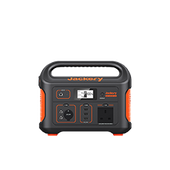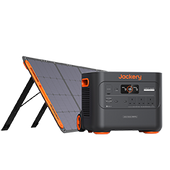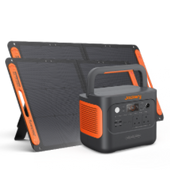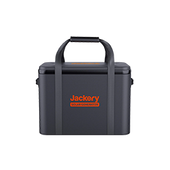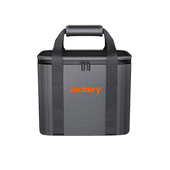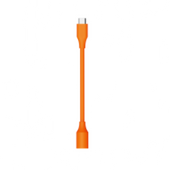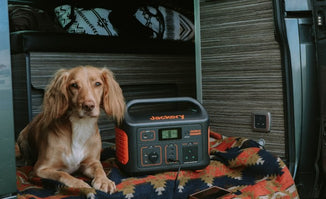Power outages can significantly disrupt an age where electricity is the primary source of our daily lives. Whether it's a sudden storm, a technical glitch, or a planned maintenance outage, power outages are inconvenient and pose a safety and health risk. When the grid fails, backup generators can provide reliable and instant power.
This guide will explain everything about backup generators in the UK, including their importance, how they work, and how to size and choose one. There are many types of backup generators classified by fuel, and we highly recommend solar generators, especially Jackery Solar Generators —solar backup power solutions for your home or business.
|
Key Takeaways: |
|
- A backup generator is a power system that provides electricity when the power source is interrupted. - Choosing the right size backup generator ensures that you have enough power during a power outage. - There are some significant factors to consider when choosing a backup generator. - Portable generators work as an alternative to backup generators in certain situations. - We recommend Jackery Solar Generator 1000 Plus or 2000 Plus as your solar backup generator for charging appliances during an emergency or power outage. - Whether buying a backup generator in the UK depends on your circumstances and needs. |
The Basics of Backup Generators
A backup generator is the perfect tool to prepare for a power outage, keeping your home powered during a power outage. In other words, a backup generator keeps your home running during storms and power outages.
A backup generator is a power system that provides electricity when the power source is interrupted. It is usually permanently installed outside a home or business.

Critical Components of a Backup Generator
First, it is essential to understand each part of a backup generator. A backup generator system has several vital components that provide reliable backup power.
|
Engine |
Typically powered by natural gas or propane, converts the energy stored in the fuel into mechanical energy. |
|
Alternator |
It converts the mechanical energy produced by the engine into electrical energy. (It works by electromagnetic induction) |
|
Voltage Regulator |
It monitors the output voltage and adjusts it as needed. |
|
Fuel System |
It includes components such as the fuel tank, fuel lines, and regulator. |
|
Control Panel |
It monitors the status of the generator and controls its operation. |
|
Enclosure |
It protects the internal components of the generator. |
|
Switch |
It automatically disconnects your home from the utility grid and connects it to the generator. |
How Does a Backup Generator Work?
When the grid typically supplies, the backup generator is in standby mode. But when the automatic transfer switch detects a power outage, the backup generator starts quickly and provides power to the user within seconds. This automatic switching ensures the continuity of the power supply and reduces the impact of power outages on production and life.
The backup generator will continue to power the home or facility until it detects that the primary grid has been restored. Once the grid power is stable, the backup generator will go through a cool-down period and then automatically shut down to restore average power to the facility.
What Size Backup Generator Do I Need?
How do you determine the size of the backup generator you need? Choosing the right size backup generator ensures that your essential appliances and systems have enough power during a power outage. A smaller backup generator will only meet your needs, while an oversized one may be unnecessarily expensive to purchase and operate. Therefore, before choosing the right backup generator, please determine your power needs:

Step 1: List all appliances and systems that must be powered during a power outage.
Properly selecting and preparing power supply equipment during a power outage can effectively reduce the impact of power outages on life and work. The appliances that need to be powered during a power outage include the following categories:
|
Lighting equipment |
LED lights, table lamps, etc. |
|
Communication equipment |
mobile phones, intercoms, etc. |
|
Medical equipment |
ventilators, heart monitors, etc. |
|
Refrigeration equipment |
refrigerators, freezers, etc. |
|
Cooking equipment |
gas stoves, gas furnaces, etc. |
|
Heating and cooling equipment |
fans, air conditioners, heaters, etc. |
|
Security equipment |
surveillance cameras, alarm systems, etc. |
Step 2: Write down the starting and running wattage of each appliance you want to power during a power outage.
Each appliance has different running and starting wattage requirements. Many appliances don't need surge power, while some require more than twice the running wattage to start and run.
- Starting wattageis the initial high wattage required to start an appliance from a complete stop.
- Running wattageis the continuous wattage required to run an appliance already running steadily.
In summary, listing the starting wattage of all the appliances you plan to power with your backup generator is crucial. While you may be running multiple appliances simultaneously, it is unlikely that you will be starting them all at once. Therefore, choose the highest starting wattage that will meet the starting wattage requirements of all other appliances.
Appliances usually have wattage numbers on the bottom, back, or nameplate. If your appliance does not have this information listed, you can check the user manual or browse the manufacturer's website to find the wattage of a specific product.
Here are the starting wattage and running wattage of some common appliances in the UK:
|
Device |
Running Watts |
Starting Watts |
|
Light Bulb |
60-75 |
0 |
|
20" Box Fan |
200 |
350 |
|
Microwave |
600-1000 |
0 |
|
Refrigerator/Freezer |
700 |
2200 |
|
Toaster |
900 |
0 |
|
Coffee Maker |
1000 |
0 |
|
Toaster Oven |
1200 |
0 |
|
Clothing Iron |
1500 |
0 |
|
Space Heater |
2000 |
0 |
Step 3: Calculate the required power, including a 20% buffer for unexpected loads.
Total running wattage of all appliances you want to power + Maximum starting wattage of the electric appliances you wish to power = Total power (minimum wattage required)
After calculating the total power, please leave a certain margin to ensure the stability and safety of the power system. (It is generally recommended to leave 20% of the total power as a margin)
Eventually, you will get the ideal power of the generator, which is the size of the generator you need.
Step 4: Common sizes of backup generators.
Backup generators have different power capacities, so consider whether you need a small, medium or large industrial generator. Some of the more popular backup generators are 20 kVA, 30 kVA, 40 kVA and 100 kVA.
Here are some examples of suitable scenarios or industries for different backup generator sizes:
|
Backup Generator Size |
Applicable Scenarios/Industries |
|
0-10 kVA |
RVs Caravans Mobile catering Emergency service vehicles Off-grid homes |
|
11-20 kVA |
Mobile catering Construction sites Railway projects Road projects Light industrial manufacturing facilities Emergency service support |
|
21-50 kVA |
Industrial power backup Construction sites Light manufacturing Music events Amusement park rides Agriculture |
|
51-100 kVA |
Industrial primary power backup Power backup for large buildings Food manufacturing Music festivals Small medical facilities Agriculture Forestry Fairgrounds Schools Military communications Ships |
Factors to Consider When Selecting a Backup Generator
You can choose a backup generator that suits your needs by considering some factors. Here are some of the essential considerations when choosing a backup generator:

Fuel Type
Backup generators can use a variety of fuels, including diesel, natural gas, and propane. Each fuel has advantages and disadvantages, so consider its availability, cost, and storage requirements when choosing.
The following are the advantages and disadvantages of different fuel types for backup generators:
|
Fuel Type |
Advantages |
Disadvantages |
|
Diesel |
High energy density Can withstand heavy loads Diesel has a long shelf life Stable fuel |
Higher initial cost Noisier operation Requires regular fuel storage Emits pollutants |
|
Gasoline |
High-cost performance Low operating noise Easier to start |
Gasoline has a shorter shelf life Gasoline is flammable Low efficiency |
|
Propane |
Clean burning, low emissions Can be stored indefinitely Portable tanks |
Higher fuel costs Limited run time based on tank size Requires regular propane refills |
|
Natural Gas |
Clean burning Environmentally friendly Fuel costs are generally lower |
Gas supply may be disrupted Not available in all areas Gas connection required |
|
Wind |
Lower carbon footprint Long-term cost-effectiveness Lower follow-up investment |
High initial investment Unstable wind energy acquisition Noise and visual pollution Requires constant maintenance |
|
Solar |
Low carbon footprint Cost-effective Low ongoing maintenance costs Low maintenance requirements Easy to use Portability |
Unstable solar energy acquisition High initial investment |
A solar generator offers a clean, environmentally friendly backup power source during outages, featuring advantages such as zero emissions, minimal maintenance, portability, silent operation, and potential cost savings compared to conventional generators, particularly for smaller power requirements or when integrated with a home solar system; however, its efficiency is contingent upon sunlight availability and may not sustain large appliances for prolonged durations.
However, since a solar generator is a combination of solar panels and portable power station, the power station can be recharged by wall outlets, so even when there is no sunlight, it can work smoothly. For example, Jackery Solar Generator combines Jackery Solar Panels with a Portable Power Station to charge large appliances with over 12 kWh capacity.

Installation Location
Consider where the generator will be installed and how it will be connected. Choose the right size generator set for the space available to ensure that there is enough space for installation and operation and that it can be easily connected to your power system.
Cost
Backup generators vary widely in price, and their initial cost is only part of the consideration. You also typically must factor in operation, maintenance, and fuel costs.
In addition, different starting methods will affect the backup generator's performance and cost. Standard starting methods are direct start, star-delta start, reduced voltage start, soft start, and variable frequency start.
Noise and Emissions
If the backup generator will be installed in a residential area or an area with strict environmental noise and emissions requirements, a low-noise and low-emission model should be selected. Silent and environmentally friendly backup generators are ideal choices in these situations.
Environmental Conditions
Environmental conditions, such as high altitude and extreme temperature, may affect the performance of a backup generator. Therefore, exceptional environmental conditions may require a specially configured backup generator.
Maintenance Requirements
Backup generators require regular maintenance, including periodic operational testing and part replacement as necessary. Consider the frequency and cost of maintenance and the availability of reliable maintenance service providers.
After-Sales Service
In addition to maintenance requirements, consider the manufacturer's after-sales service and warranty policy. Good after-sales service ensures the backup generator is always in good condition when needed. It includes installation support, maintenance services, and spare parts supply.
Automation Features
The automated features of modern backup generators (auto-start and auto-switching to backup power) are critical to ensuring seamless power when the primary power fails. Therefore, consider whether you need an automatic transfer switch to start your backup generator automatically during a power outage.
Jackery Solar Generators: Solar Backup Power
Using a solar generator as a backup power supply has many benefits. In contrast to gasoline generators, solar generators operate with minimal noise owing to the absence of combustion engines. They necessitate minimal maintenance, primarily battery inspections and periodic cleaning of solar panels.

It offers a supplementary power source during grid failures, affording you autonomy over your electrical supply. Although the initial expenditure may be elevated, the absence of fuel expenses might result in considerable savings over time, particularly with regular usage. Here, we recommend the Jackery Solar Generator, which is portable, powerful, and easy to use.
|
Appliances |
Working Hours |
|
|
Jackery Solar Generator 1000 Plus (1.25-5 kWh) |
Jackery Solar Generator 2000 Plus (2-12 kWh) |
|
|
Refrigerator (700W) |
1.5-6.1H |
2.4-14.6H |
|
Computer (200W) |
5.4-21.3H |
8.5-51H |
|
Office Printer (300W) |
3.6-14.2H |
5.7-34H |
|
Lighting (50W) |
21.4-85H |
34-204H |
|
AC (1000W) |
1.1-4.25H |
1.7-10.2H |
Jackery Solar Generator 2000 Plus
Jackery Solar Generator 2000 Plus is the most suitable generator for home or business backup, a solid portable power solution that delivers outstanding performance. With its impressive capacity and powerful output, this device can support the operation of essential appliances for weeks, even certain large appliances, such as your refrigerator, computer, AC, etc. In your home or company.

- Expandable Powerhouse for Your Appliances: The Jackery Solar Generator 2000 Plus enables the addition of extra battery packs, increasing the capacity from 2 kWhto an impressive 12 kWh, thereby significantly satisfying your power needs. This solar product has a remarkable output of 3000W, providing a 30% higher rated power than other 2 kWh solar products. Almost all essential appliances are powered.
- Safe to Use with ChargeShield: ChargeShield is Jackery's advanced fast charge technology, featuring 62protective mechanisms, 12 protective algorithms, and four types of physical safety protection. This technology uses a unique stepped variable-speed charging algorithm to enhance safety and extend battery pack lifespan by 50%.
- Higher Resistance & Reliability: The Explorer 2000 Plus stands out as a groundbreaking add-on battery pack that offers the convenience of recharging through solar panels. This feature increases versatility, boosts charging efficiency, and shortens charging time. Also, it can be taken indoors safely compared to other traditional backup generators.
|
*Review from Our User |
|
I have been using Jackery batteries for a long time. I felt great excitement upon the release of the Explorer 2000 Plus, which marks the inaugural release of an expendable battery system by Jackery. The system supports a capacity of up to 12kWh with a 3000W 120V output or 24kWh with a 6000W 240V output—an ideal enhancement for my home backup system. |
Jackery Solar Generator 1000 Plus
Jackery Solar Generator 1000 Plus combines SolarSaga 100W solar panels with Explorer 1000 Plus. The Explorer 1000 Plus is the same as the Explorer 2000 Plus, which is the expandable LiFePO4 battery to be added to a 5 kWh capacity. If Jackery Solar Generator 2000 Plus is for charging your appliances for a few weeks, this solar generator is for charging for several days.

- Excellent Power Output: The Explorer 1000 Plus power station boasts an excellent 1264Wh long-lasting LiFePO4 battery and a 2000W full-power pure sine wave inverter, supplying almost all required power. Adding up to three additional battery packs will remarkably increase its capacity to 5kWh.
- Expandable Powerhouse: Adding up to three extra battery packs lets Jackery's exclusive technology boost the Explorer 1000 Plus capacity from 26kWh to5kWh. Moreover, it has a maximum output of 2000W, 20% more than usual 1kWh LFP generators.
- Higher Solar Conversion Rate: The Jackery SolarSaga 100W Solar Panel boasts a solar conversion rate of up to 25%; it is optimally designed for outdoor use and unforeseen power interruptions. The solar panel weighs about 8 lbs, is lightweight, foldable, and equipped with a convenient carry handle, enhancing its portability.
|
*Review from Our User |
|
First, this item is robust and space-efficient, fitting seamlessly in my workspace (see pic). When the power goes out, it becomes a real game changer. I can continue my tasks as if everything is normal, which is impressive. The most advantageous aspect for me? The USB-C ports. I can connect my Mac directly to it without needing an adapter. Incredibly useful! |
Can a Portable Generator Replace a Backup Generator?
Portable generators are widely used in various situations because they are light and easy to carry. However, several aspects must be carefully considered when replacing a backup generator with a portable one.
Power Output
backup generators are usually designed to provide enough power to support the operation of an entire home or commercial facility during a power outage. Portable generators are relatively small in power and are more suitable for providing power to specific equipment or a small area. Therefore, portable generators may only partially replace backup generators when a comprehensive power supply is required.
Continuous Operation Time and Fuel Efficiency
backup generators are usually equipped with large-capacity fuel tanks and efficient fuel systems, which can continuously provide power for a long time. In contrast, portable generators have smaller fuel tanks due to size and weight limitations and must be refuelled more frequently.
Convenience of Operation
backup generators can automatically start to power your property after the main power is interrupted. In contrast, portable generators must be started so they cannot provide a stable, uninterrupted power supply. In addition, portable generators also require a power extension cord to be connected from the generator to the appliances to be powered.
Space Occupied
Land use in the UK can be a limiting factor for backup generators. Unlike fixed backup generators, portable generators are compact in design, which allows them to be placed in limited spaces. For example, some portable solar generators are only the size of an ordinary suitcase and can be placed in any corner of the home. In contrast, fixed generators require a dedicated area for installation.
Difficulty of Disassembly and Cleaning
Easy disassembly and cleaning is another significant advantage of portable generators. Regular cleaning and maintenance of the generator equipment helps maintain power generation efficiency in wet or dry weather and prevents stains or dust from blocking sunlight.
In addition, portable generators are easy to disassemble for thorough maintenance and inspection.
|
Generator Types |
Advantages |
Disadvantages |
|
Backup generators |
• Stable power supply • High power output • Long continuous operation time • Many options • Quick start-up • Easy operation |
• Loud noise • Large space occupied • High maintenance cost • Fuel storage and supply • Environmental pollution • Difficulty in maintenance |
|
Portable Generators |
• Highly portable • Excellent electrical performance • Low initial cost • Low maintenance cost • Small footprint • Simple installation • Easy to disassemble and clean |
• Short run time • Power limitations • Requires additional accessories • Requires manual start |
In summary, portable generators can substitute backup generators in certain situations. For example, a portable generator is more suitable when a temporary power source is needed during camping, fieldwork, or an emergency. However, a standby generator is more appropriate for high-power output scenarios and long-term continuous power supply.
Therefore, when choosing whether to use a portable generator instead of a backup generator, users should compare these pros and cons according to their needs and scenarios and make the most appropriate choice.
Is It Worth Getting a Backup Generator in the UK?
Whether it is worthwhile to buy a backup generator in the UK depends on a variety of factors. In addition, you need to decide based on your specific situation and needs. Alternatively, you can consult a professional directly for advice. Before deciding, it is recommended to evaluate the following four factors in detail.
Frequency of Power Outages
If you live in an area with frequent power outages, purchase a backup generator. It can provide electricity to your home or business during power outages, ensuring basic life and work continuity.
Power Needs
A small portable generator may be sufficient if you power a few essential household appliances (such as refrigerators, lighting, and TVs). However, a large backup generator may be required to power your home or business.
Budget
Purchasing a standby generator requires maintenance, fuel costs, and a specific initial investment. You need to assess whether these costs are within your budget.
|
Backup Generator Size |
Cost + VAT (supply only) |
Installation (approx. 2-3 days) |
|
1kW |
£300 |
£1,000 |
|
7kW |
£2,000 |
£1,000 |
|
15kW |
£6,000+ |
£1,000 |
|
45kW |
£10,000+ |
£1,000 |
(The data in the table are approximate average values and are for reference only.)
Installation and Maintenance
You may need to hire a professional to install and regularly maintain your generator to ensure it works when needed. It would help if you also considered its aftercare.
Backup Generator in The UK FAQs
The following are the frequently asked questions about the backup generators in the UK:
- What is a backup generator?
A backup generator is a permanently installed device that provides backup power to a home or office space in the event of a power outage. It is widely used in commercial buildings, hospitals, schools, factories, and personal residences to ensure critical equipment and systems can continue operating if the primary power source is unavailable.
- Are backup generators worth it?
Backup generators are indispensable equipment for enterprises and critical locations that require continuous power supply.
In short, investing in backup generators is undoubtedly a wise choice in the face of frequent or unstable power outages.
- Can you use a backup generator 24/7?
Theoretically, you can use a backup generator 24/7. Some models can even run for weeks if properly maintained and fueled. However, they should still be considered a temporary solution, not a permanent power source.
- What size generator do I need to back up my house?
The backup generator size you need to power your house depends on your power needs. Generally, a 5,000—to 8,000-watt generator is enough to power an average home. It can power essential appliances such as air conditioners, sump pumps, refrigerators, laptops, TVs, and light bulbs.
Final Thoughts
A backup generator keeps your home running during storms and power outages, keeping your lights on, your food fresh, and your family comfortable. Despite the high initial cost, backup generators offer a variety of long-term benefits. In short, having a backup generator in your home can mitigate the effects of a power outage, allowing you to continue to live and work comfortably no matter what happens. Besides, we suggest you invest in a Jackery Solar Generator since it is portable, clean, and safe; you can even take it into your house.









